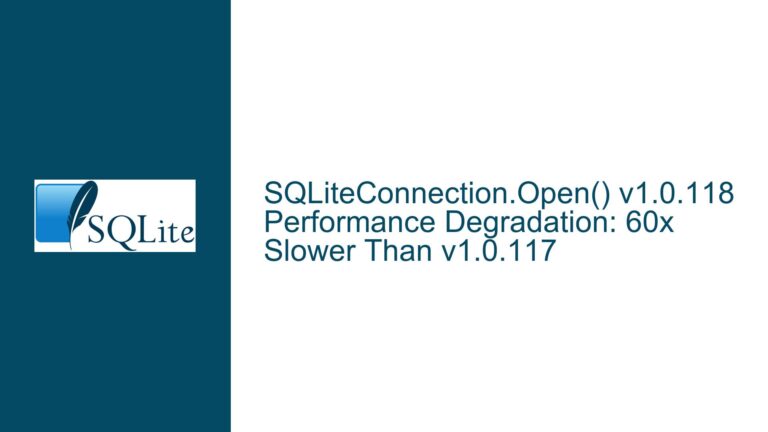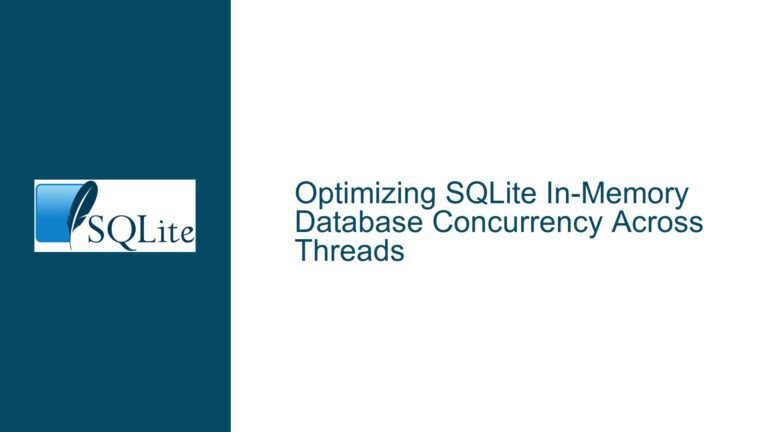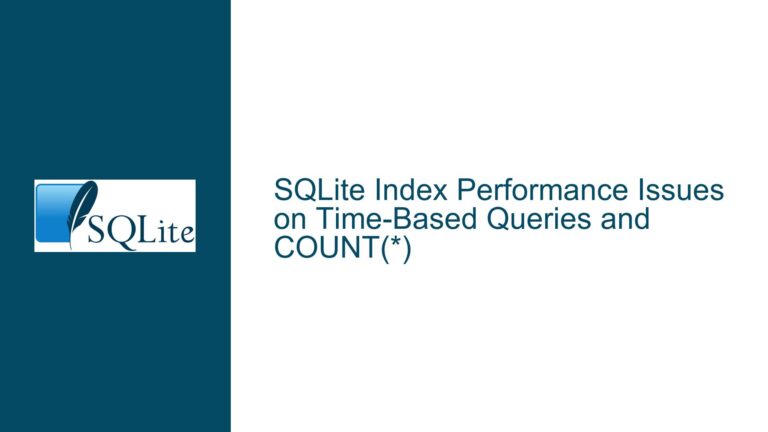Multithreaded Query Execution in SQLite: Limitations and Practical Considerations
Fundamental Architecture Constraints for Parallel Query Execution
The core issue revolves around attempting to parallelize the execution of a single SQL query across multiple threads within SQLite. This requires a deep understanding of SQLite’s design philosophy, its virtual machine architecture (VDBE), concurrency controls, and how these components interact with threading models. Below, we dissect the technical landscape that governs this scenario.
1. SQLite’s Threading Model and Query Execution Mechanics
VDBE Bytecode and Single-Threaded Execution
SQLite processes queries by compiling them into a sequence of bytecode operations executed by its Virtual Database Engine (VDBE). Each connection to the database operates in a single-threaded context by default. The VDBE bytecode is inherently sequential, relying on cursor states, register values, and program counters that assume linear execution. For example, the Rewind opcode resets a cursor to the beginning of a B-tree index or table. Introducing thread-local cursors with offsets (as proposed) would require atomic coordination of cursor positions across threads, which conflicts with SQLite’s cursor management logic.
B-Tree Cursors and Shared Access
Each thread opening "local cursors into the same set of B-trees" implies shared access to the underlying storage structures. SQLite’s B-tree layer uses page-level caching and relies on a single write-ahead log (WAL) or rollback journal. While multiple readers can coexist in WAL mode, concurrent write operations are serialized. Threads attempting to scan the same B-tree with independent cursors would compete for access to the same pages, leading to cache invalidation or lock contention.
Locking and Result Row Coordination
The proposal suggests a custom ResultRow opcode that acquires a lock before passing results to a main thread. SQLite’s existing locking hierarchy (UNLOCKED, SHARED, RESERVED, PENDING, EXCLUSIVE) is designed for process-level isolation, not intra-query thread synchronization. Implementing a fine-grained lock for result row handoff would require bypassing SQLite’s native lock manager, risking undefined behavior or data races.
2. Critical Challenges in Multithreaded Query Execution
VDBE Bytecode Non-Parallelizability
The VDBE bytecode for a query like SELECT ... FROM table1 JOIN table2 ON ... WHERE ... includes opcodes such as OpenRead, Column, Seek, and ResultRow. These opcodes assume a single execution context. Parallelizing them would require splitting the bytecode into thread-safe segments, which is infeasible due to dependencies between opcodes. For example, a Seek operation in one thread could invalidate the cursor position used by another thread.
Thread-Local Variable Space and Shared State
While thread-local variables might isolate register values, SQLite’s internal structures (e.g., the page cache, schema memory) are shared across connections. Modifications to these structures without proper synchronization could corrupt the database state. Additionally, the sqlite3 API is not thread-safe by default unless compiled with SQLITE_THREADSAFE=1, and even then, connections are thread-confined.
B-Tree Page Cache Contention
Each thread opening cursors into the same B-trees would compete for access to the in-memory page cache. SQLite’s page cache is designed for per-connection isolation, not shared access. Concurrent scans would lead to frequent cache misses or thrashing as threads evict each other’s pages.
Lock Manager Overhead
Introducing a custom lock for result row handoff would add significant overhead. SQLite’s existing locks are coarse-grained and optimized for transactional boundaries, not row-level coordination. A naive implementation could bottleneck the main thread, negating any performance gains from parallelism.
3. Strategies for Diagnosis, Mitigation, and Alternatives
Diagnosing Concurrency Conflicts
- Enable Debugging Features: Compile SQLite with
-DSQLITE_DEBUGand usesqlite3_config(SQLITE_CONFIG_LOG, ...)to log lock states and VDBE execution traces. - Monitor Page Cache Activity: Use
PRAGMA cache_stats;to observe cache utilization under load. Highpage_missesindicate contention. - Profile Thread Interactions: Use OS-level tools (e.g.,
perfon Linux, Instruments on macOS) to identify lock contention or CPU stalls.
Mitigating Parallelization Pitfalls
- Use Connection Pooling: Assign separate database connections to each thread, ensuring transactional isolation. This leverages SQLite’s process-level concurrency (e.g., WAL mode) without violating its threading constraints.
- Partition Data Explicitly: If the query scans a range of rows, partition the table by rowid or indexed columns and assign each partition to a thread. For example:
-- Thread 1: rows 1–1000 SELECT ... FROM table WHERE id BETWEEN 1 AND 1000; -- Thread 2: rows 1001–2000 SELECT ... FROM table WHERE id BETWEEN 1001 AND 2000; - Batch Processing with Application-Side Coordination: Use a queue to distribute row ranges to worker threads, aggregating results in the main thread.
Alternative Approaches
- Leverage SQLite’s Built-In Parallelism: Use
PRAGMA threads=N;(if available) for specific operations likeVACUUMorREINDEX, though this does not apply to arbitrary queries. - Offload Compute-Intensive Tasks: Perform joins or filtering in the application layer after retrieving raw data.
- Consider Alternative Databases: For workloads requiring intra-query parallelism, use systems like PostgreSQL (parallel sequential scans) or DuckDB (vectorized execution).
Code-Level Workarounds (Advanced)
- Custom Virtual Tables: Implement a virtual table that internally partitions data and processes chunks in parallel.
- SQLite Session Extension: Use
sqlite3sessionto track changes and merge results from multiple threads.
This analysis underscores that while SQLite’s simplicity and embeddability are strengths, its architecture imposes strict limits on intra-query parallelism. Success requires adhering to its concurrency model or re-architecting the application to align with SQLite’s design constraints.






